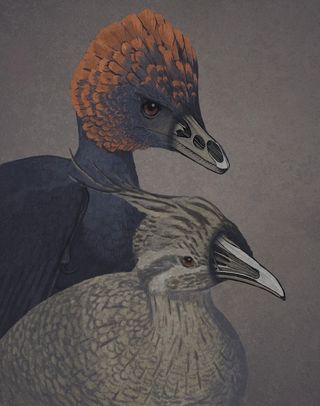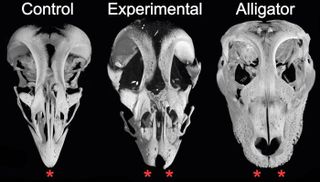Dino-chicken gets one step closer

Talk of a "chickenosaurus" lit up the science world last week when researchers announced they had modified the beak of a chicken embryo to resemble the snout of its dinosaur ancestors. But although some experts have lauded the feat, a beak is just one of many modifications needed to revert a chicken into a dinosaur.
Given these obstacles, how close are scientists to creating a dino-chicken?
"From a quantitative point of view, we're 50 percent there," said Jack Horner, a professor of paleontology at Montana State University and a curator of paleontology at the Museum of the Rockies.
Related: See images of the chicken embryos with dinosaur-like snouts
Horner has long supported the idea of modifying a chicken to look like a dinosaur, and unlike the researchers on the latest study, he actually wants to raise a live one. And why stop there? By understanding how and when to modify certain molecular mechanisms, countless changes could be within reach. As Horner pointed out, a glow-in-the-dark unicorn is not out of the question.
There are four major modifications needed to make a so-called chickenosaurus, Horner said. To turn a chicken into a dinosaurlike beast, scientists would have to give it teeth and a long tail, and revert its wings back into arms and hands.
The creature would also need a modified mouth — a feat accomplished by the researchers who did this latest study, he said.
Sign up for the Live Science daily newsletter now
Get the world’s most fascinating discoveries delivered straight to your inbox.
"This dino-chicken project — we can liken it to the moon project," Horner told Live Science. "We know we can do it; it's just there are … some huge hurdles."
Challenges ahead
One of those "huge hurdles" was cleared in the latest study, published May 12 in the journal Evolution, in which researchers turned chicken beaks into dino snouts. But even that seemingly small step involved seven years of work. First, the researchers studied beak development in the embryos of chickens and emus, and snout development in the embryos of turtles, alligators and lizards.

It's likely that millions of years ago, birds and reptiles had similar developmental pathways that gave them snouts, but over time, molecular changes led to the development of beaks in birds, the researchers said.
It's difficult for scientists to get embryos of present-day animals, such as crocodiles, to compare because they have to find farms that raise them. And then, the molecular work — determining exactly which developmental pathways are different, how they're different and what controls them — can take "countless hours and hundreds of experiments for a few successful ones," said the study's lead researcher, Bhart-Anjan Bhullar, a paleontologist and developmental biologist currently at the University of Chicago and cross-appointed at Yale University, where he will be starting as full-time faculty. "It's kind of the same as fossil finding."
For their "fossil finding," the researchers needed an extensive fossil record of birds and their ancestors to see what birds looked like at different stages of their evolution.
"You have to understand what you're tracing before you try to trace it," Bhullar told Live Science.
Bhullar; his doctoral advisor Arkhat Abzhanov, a developmental biologist at Harvard University; and their teammates focused on two genes that are active in facial development. Each gene codes a protein, but the proteins — which carry out the work of genes — showed different activities in modern-day chicken and reptile embryonic development, the researchers found. When the researchers blocked the activity of these two proteins in chickens, the birds developed structures that resembled snouts, not beaks.
Unexpected find
And then there's the unexpected finding that revealed the complex task at hand: When the group transformed the beaks of chicken embryos into snouts, they also inadvertently changed the chicken's palate, or roof of the mouth.
In contrast, the palates of the bird embryos were broad and flat, and connected "to the rest of the skull in a way that ancestral reptiles' palatines did, but bird palatines do not," Bhullar said.In birds, "the palatine bone is really long and thin, and it's not very connected with other bones of the skull," Bhullar said. In fact, birds can lift up their top jaw independently of their lower jaw — an ability not seen in most other vertebrates.
So, by changing the beak, the researchers also changed the palate. When the researchers went back to the fossil record, they found that the snout and palatine bone appeared to change together throughout evolution. For instance, an 85-million-year-old fossil of a birdlike creature that had teeth and a primitive beak also had a birdlike palate, they said.
Related: Infographic: How to make a dino-chicken
However, in an even older fossil, the palatine was not transformed, and neither was the beak, Bhullar said.
"Part of that is verifying experimentally whether the molecular changes we see are actually able to change the anatomy in the ways we predicted," Bhullar said. "In a way, that recapitulates the change we see in the fossil record."
But his goal "is simply to understand, in as a deep a way as possible, the molecular mechanisms behind major evolutionary transitions," he said. He's not interested in making "a more nonavian, dinosaurlike bird."
Will it work?
But Horner is interested in making a so-called chickenosaurus. His group is currently working on giving the chicken a long tail— arguably, the most complex part of making a dino-chicken, he said. For instance, they just screened genes in mice to determine what types of genetic pathways block tail development. This knowledge could help them figure out how to switch on tail growth, he said.
Related: Real or fake? 8 bizarre hybrid animals
But it remains to be seen how chickens would react to tails, arms, fingers and teeth, Bhullar said.

But, on the other hand, chickens may be resilient creatures."Just because you changed one part doesn't mean that the animal will be able to use it or be able to use it correctly," he said. "You could perhaps give a chicken fingers, but if the fingers don't have the right muscles on them, or if the nervous system and the brain are not properly wired to deal with a hand that has separate digits, then you may have to do a considerable amount of additional engineering."
"People also sometimes underestimate plasticity [flexibility] of the body," Bhullar said. "It's amazing how much compensation goes on, and the nervous system, in particular, is very plastic."
Bhullar said that, if dinosaurlike features, such as a snout and teeth, were to be restored, he wonders "whether the brain wouldn't rewire itself in some way that would permit these animals to use these features."
Horner likened giving a chicken a dinosaurlike tail to breeding a wolf into a Chihuahua, except that it was on an accelerated timescale.
"We've got all sorts of genetically modified animals already just from breeding," he said. "We [could] make a dino-chicken, and we [could] make a glow-in-the-dark unicorn. Basically, we can make anything we want, I think, once we understand the genes.
"And the question is, 'Why would anyone care if they don't care about a Chihuahua?'" Horner added.
For him, the chickenosaurus is about answering the biggest question of all.
"Any of us that have any curiosity about how we all got here and where everything came from has to be interested in evolutionary biology," Horner said. "It's basically the blueprint of life on this Earth."
Originally published on Live Science.

Laura is the archaeology and Life's Little Mysteries editor at Live Science. She also reports on general science, including paleontology. Her work has appeared in The New York Times, Scholastic, Popular Science and Spectrum, a site on autism research. She has won multiple awards from the Society of Professional Journalists and the Washington Newspaper Publishers Association for her reporting at a weekly newspaper near Seattle. Laura holds a bachelor's degree in English literature and psychology from Washington University in St. Louis and a master's degree in science writing from NYU.
Most Popular


